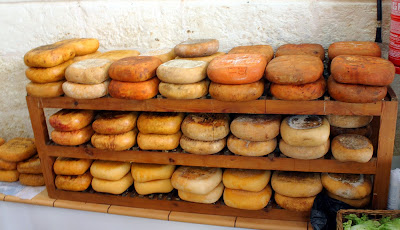It’s been a rubbish week. Laid low with a vicious bug, lethargy has been the order of the day. I’ve barely eaten a thing, spent 10 hours at a time in bed and struggled to leave the house. Even the thought of a glass of wine has left me cold.
But now it’s time to shake off the self-pity and head off to Menorca for the last time this year. It’s a journey we make each year to Punta Nati, a remote, unforgiving and brutal landscape of rocks and field after field of moonscape with dwarf vegetation but where speciality birds abound. Don't forget to "click the pics" for better images.
We left our hotel soon after breakfast, found our way to the Me1 and joined the commuter run to Ciutadella, Menorca’s second city. The Ronda, the Ring Road, skirts the busy city where with luck we’d find the purple signpost that would send us to the parallel world of Punta Nati just ten minutes from the old world charms of Ciutadella.
I pulled the car into the barely possible parking spot, the wing mirror just a whisker from the stone wall. The old fellow came out to greet us as he always does and explained again in zero English how the Cattle Egret colony here is the only one for many miles, maybe even the only one in Menorca. In my best zero Spanish I nodded in agreement and motioned with the camera that a few shots later we’ll be on our way and leave the egrets to their squawking family squabbles and bad hair days.
Cattle Egret
Cattle Egret
Cattle Egret
Towards the point Bee Eaters were on the move, circling high in the sky, resting on overhead wires and bubbling out their unforgettable contact calls. There’s urgency in their excited calls. Some drift off, others move closer together before as a group their calls grow more eager and they’re off as one, specks in the sky and heading over the lighthouse, over the Med and towards Europe.
Bee-eater
Punta Nati
The calls of larks, buntings and pipits are constant as all seem to be in the throes of breeding. Searching for food, looking out for their nests, warning of predators or snatching a song; it’s all in a day’s work where the dry atmosphere and unrelenting sunshine takes its toll on a bird’s plumage.
Thekla Lark
Short-toed Lark
Tawny Pipit
Tawny Pipit
Corn Bunting
Towards the lighthouse we eventually found a pair of Blue Rock Thrush, the calls of the male leading us to the spot where the pair lived. A Kestrel watched us as we went, the species is a common sight dashing across the bare fields and where there are more than enough vantage points. Red Kites lazed through the skies, their twisty tails a delight to watch in the remarkable blue of a Menorca sky.
Punta Nati
Red Kite
Kestrel
An hour or two later the trippers arrive, fresh from their tourist maps looking for something to do, something to see, a little excitement on a sunny day. But unless they are into birds, and very few are, there’s little for to do except walk without purpose to the lighthouse and back, trample over unforgiving terrain along coastal paths and maybe sprain an ankle. Most give up at the sheer desolation of the place, jump back in their shiny hire cars and probably vow never again to visit Punta Nati.
We’ve had our fun, seen some great birds, laughed at a few German tourists with their huge knapsacks and knobbly white knees but we kept the secret of Punta Nati. Now it’s time for a trip to the busy city ten minutes away.
We park in the main square for all of two Euros and head to some favourite watering holes.
Ciutadella
The Aurora
Diageo's
The Harbour - Ciutadella
Ciutadella is a fabulous place, a working Spanish city which remains untainted by the tourism that has blighted so many other similar places. And after a dry, dusty trip birding along Memory Lane, what better than a coffee or two, an ensaimada or a bocadillo and a spot of people watching for a change?
Linking today to Eileen's Saturday.
Linking today to Eileen's Saturday.






























































































